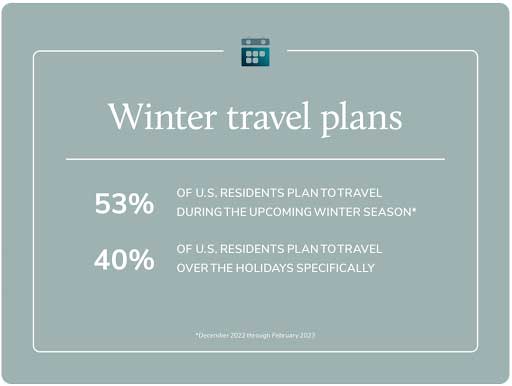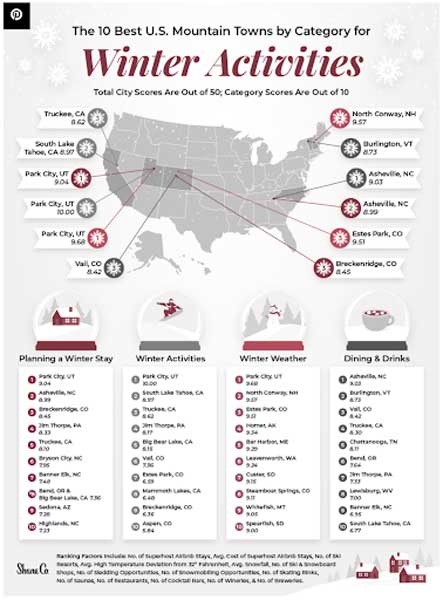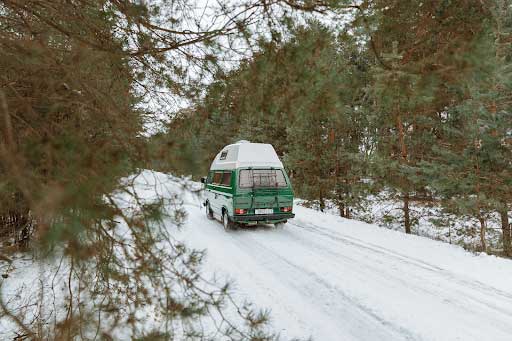by Alejandra Leyva
Did you know that over half of Americans are planning to have a winter trip?
North America’s leading vacation rental management platform, Vacasa, partnered with Allison+Partners Research to survey winter travel in 2022. The report revealed that 53% of U.S. residents planned to travel from December 2022 to February 2023.
If you plan to travel this year, you might be thinking of what mountainous regions to visit. Take it from The Loupe with its Best U.S. Mountain Towns for a Winter Getaway report. Here are some of its key findings and top recommendations you ought to know:
Try visiting Park City, Utah, the best U.S. mountain town, or Juneau, Alaska, with a snow-covered wonderland.
Head off to Big Bear Lake, California, with nearly 70 ski and snowboard shops to get gear from.
But if you’re looking for affordable or posh accommodations, try Davis, West Virginia, and Custer, South Dakota, for the cheapest Airbnb rentals or Mammoth Lakes, California, and Aspen, Colorado, for extravagant stays.
Sure, winter travel in mountainous regions can be fun and exciting. However, the harsh weather conditions and rugged terrains present unique challenges and require ample preparation.
Don’t worry—we’ll share some practical tips for winter travel in mountainous regions. Find out how to ensure a safe, enjoyable winter trip in the mountains.
1. Stay updated on the weather
Start by checking the weather, even if you’re going to travel via a four-season travel trailer. As you can see, mountainous regions have sudden weather changes, especially during winter.
As such, have weather forecasts before and during your journey to plan and prepare for the following challenges:
- Heavy snowfall: Track expected snowfall as possible accumulation can cause road closures and compromise your driving.
- Icy Roads: Check for icy road conditions as they can pose a hazard risk, particularly in steep mountain areas.
- Freezing temperatures: Forecast the temperatures as freezing ones can negatively affect your well-being and driving.
- Speedy winds: Anticipate high winds in mountainous areas as they can worsen cold temperatures, cause drifting snow, and reduce road visibility.
- Possible avalanche: Be wary of avalanche warning advisories to ensure road safety.
2. Get your vehicle ready
Prepare your vehicle for winter travel in the mountains, whether it’s a used Jeep Grand Cherokee or a Lance travel trailer. Doing so guarantees your passengers’ safety and the transportation’s overall reliability.
That said, follow the crucial steps below to get your vehicle ready for the driving obstacles:
- Check brakes: Your brakes must be in top shape and working conditions since icy and steep roads require optimal braking performance.
- Inspect tires: If possible, examine your tires and switch to snow tires for enhanced traction on snowy and icy roads.
- Maintain battery health: Test your battery, charge it fully, or replace it whenever necessary since cold temperatures can badly strain it and cause an unexpected breakdown.
- Maintain fluid levels: Keep all vital fluids at their recommended levels, including oil, coolant, and windshield washer fluid.
- Ensure full gas tank: Your gas tank should be at least half full to prevent freezing fuel lines and ensure enough for winter travel.
3. Pack warm winter clothes
Looking to stay warm, comfy, and safe while heading southbound for your annual winter trip? The right clothing choice is key! Pack a critical selection of insulated garments best suited for the cold winter season in mountainous areas.
That said, here’s a checklist of vital clothes for you:
- Insulated jacket: Invest in a high-quality insulated coat to provide warmth without compromising ease of movement.
- Waterproof boots: Opt for waterproof and insulated footwear to keep your feet dry throughout the winter trip.
- Thick gloves: Pack insulated gloves or mittens to protect your hands from the extreme cold.
- Insulated hat: Wear a warm hat to prevent heat loss from your head and for additional protection.
- Neck Gaiters: Include these accessories in your list of essentials for additional warmth and protection.
- Moisture-wicking socks: Bring several pairs of insulated socks to keep your feet warm and dry.
- Snow pants: Pack waterproof and insulated pants if you anticipate being outdoors in snowy conditions.
- Layering Options: Pack layers of clothing you can easily add or remove for the changing weather conditions.

4. Have emergency supplies on hand
Emergency can strike anytime, anywhere, especially when traveling in mountainous areas during winter. What if you get injured on vacation? As such, prepare for unexpected situations by having a well-stocked emergency kit.
That said, here’s a comprehensive list of emergency supplies to carry:
- First aid kit: The kit must have the essentials like bandages, antiseptic wipes, pain relievers, and prescription medications.
- Essential vehicle tools: Carry a set of basic tools for minor vehicle repairs or adjustments.
- Sleeping bags: Have extra blankets or bags for warmth in case of a breakdown or unexpected delay.
- Non-perishable food: Pack non-perishable snacks, like granola bars, nuts, and dried fruits, to keep you fueled throughout the journey.
- Bottled water: Carry enough water to stay hydrated throughout the winter travel.
- Portable charger: Ensure your mobile phone stays charged with a portable charger or power bank.
- Multipurpose knife: A versatile knife can be a handy tool for various tasks, from opening packages to minor repairs.
- Map and compass: A physical map and compass can help with navigation, especially in areas with limited cell service.
5. Follow local travel rules
Traveling through mountainous regions in the U.S. during winter requires local and regulatory adherence. Let’s take a trip westward through Cimarron Canyon to the historic Santa Fe Trail at Cimarron, New Mexico. You must check with the local authorities on the travel requirements you should meet.
But for your reference, here are common local regulations to be aware of:
- Chain Requirements: You might need to comply with the snow chain requirements on vehicles in mountainous areas prone to heavy snowfall or icy conditions.
- Road Closures: Stay updated on road closures and restrictions during winter, as some mountain passes or roads may not be passable.
- Parking Regulations: Check parking restrictions in popular winter destinations since illegally parked vehicles can block snow removal initiatives.
- Speed Limits: Follow the required speed limit and even reduce it during winter weather.
- Avalanche Zones: Be wary of areas prone to avalanches and check with local authorities for any restrictions or warnings.
- Vehicle Inspections: Some regions may require inspections to ensure vehicles are equipped for winter conditions.
- Travel Permits: You may need special permits to access certain mountainous areas, especially national parks or wilderness areas.
- Environmental Regulations: Strictly follow the local ecological regulations like restrictions on off-road travel or camping.
6. Plan your journey in advance
It’s best to plan your journey way ahead of time. What better way to proceed with this than to create an itinerary and travel routes? Doing so ensures smooth, safe travel in mountainous areas during winter.
That said, here are a few key steps to follow for your winter travel:
- Map out the route: Use reliable mapping tools to lay out your route, including key landmarks, potential rest stops, and alternate paths in case of road closures.
- Check road conditions: Stay informed about road closures and conditions like poor highway designs to ensure driving safety.
- Book accommodations: Check and reserve accommodations in advance, particularly if you are traveling during peak winter months.
- Search for fuel stops: Plan fuel stops strategically, especially in remote areas where gas stations might be scarce.
- Have rest breaks: Schedule regular breaks to prevent fatigue, especially during long drives.
- Check local attractions: If you have time, identify local attractions or scenic spots along your route so you can enjoy them and take some IG-worthy photos.
7. Drive safely at all times
The final step is the most crucial part—the actual driving for your winter travel. Remember that you will be traveling in the mountains during the winter season. As such, take a power nap and have all the rest you need to be physically and mentally ready for the trip. And stay on top of all the travel plans and preparations mentioned above.
That said, here’s how to drive safely and responsibly in challenging winter conditions and mountainous areas:
- Maintain lower speed. You even need to reduce it during limited visibility and slippery roads.
- Keep a safe distance. You can do this by increasing the distance behind the vehicle in front of you.
- Use headlights. You must keep them on to enhance visibility and prevent accidents, even during the day.
- Avoid sudden movements. You must steer and brake smoothly to avoid skidding, especially since you’re driving on icy or snow-covered roads.
- Brake early and gently. You must take brakes as early and gently as possible to avoid skidding.
- Stay in designated lanes. You must avoid overtaking in challenging conditions at all costs!
- Use turn signals early. You should signal your intentions well to give other drivers ample time to react.
- Stay calm in bad situations. If conditions become too challenging, you must find a safe place to wait until the weather improves.
Ensuring Safe and Smooth Winter Mountain Travel
Nothing can be more exciting than a winter trip in the mountains. However, you’ve got to ensure a safe and smooth travel. As such, consider the practical tips recommended above, from staying updated on the weather to driving safely at all times.
With enough preparation and safety compliance, winter travel in mountainous regions can be a gratifying experience. So whether in the mountainous Park City or Juneau with their winter wonderlands, stay informed, be prepared, and drive responsibly. Ultimately, have a smooth and safe journey!
©Alejandra Leyva, for Legends Of America. Submitted January 2024.
 About the Author: Alejandra Leyva is a food enthusiast, digital nomad & content creator. She follows #deleteBigTech and practices the Live Slow & Do More way of life. Find her on X (formerly known as Twitter) and via her website here.
About the Author: Alejandra Leyva is a food enthusiast, digital nomad & content creator. She follows #deleteBigTech and practices the Live Slow & Do More way of life. Find her on X (formerly known as Twitter) and via her website here.
Also See:
Easy Travel Organization Tips You Will Love
Plan Ahead to Lower Stress and Enjoy Your Getaway
Tips for Traveling in the Desert



